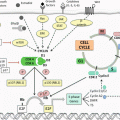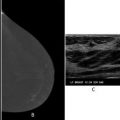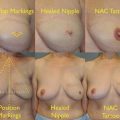Study
Intervention
Positive margin rate
Re-excision rate
Arm
n
%
p-value
%
p-value
Comice
MRI
816
13%a
n/s
16%
0.77
No MRI
807
15%a
19%
Monet
MRI
74
n/s
n/s
45%b
0.069
No MRI
75
n/s
28%b
SOC
116
34%
21%
Some have argued that perhaps MRI is better for helping surgeons achieve negative margins in patients with DCIS, as these patients may be more likely to have positive margins. A meta-analysis which evaluated the use of MRI in patients with DCIS, however, concluded that MRI did not significantly affect margin status nor re-excision rates in these patients [15].
Localization Techniques for Non-palpable Tumors
With the widespread adoption of screening mammography, many of the malignancies we identify are not palpable. Indeed, even for those that present with palpable tumors, the use of neoadjuvant chemotherapy often renders these non-palpable. Hence, there has been increasing focus on whether different techniques for localization for these tumors may affect our ability to achieve negative margins at the initial surgical procedure. A recent Cochrane analysis found that there is no significant difference between wire localization, radio-occult lesion localization (ROLL) or radioactive seed localization (RSL) in terms of margin positivity and re-excision rates [16]. Several studies comparing these techniques and their impact on positive margin and re-excision rates are shown in Table 5.2.
Table 5.2
Type of localization for non-palpable lesions
Study | Intervention | Positive margin rate | Re-excision rate | |||
|---|---|---|---|---|---|---|
Arm | n | % | p-value | % | p-value | |
Postma et al. [29] | ROLL | 162 | 14% | 0.644 | 12% | 0.587 |
WGL | 152 | 12% | 10% | |||
Duarte et al. [30] | ROLL | 64 | 59% | n/s | 25% | n/s |
WGL | 65 | 60% | 19% | |||
Gray et al. [31] | RSL | 51 | – | – | 26% | 0.02 |
WGL | 46 | – | 57% | |||
Rarick et al. [32] | RSL | 44 | 23% | 0.69 | – | – |
WGL | 62 | 24% | – | |||
Bloomquist et al. [33] | RSL | 72 | 19.4% | 0.53 | – | – |
WGL | 59 | 15.3% | – | |||
Sharek et al. [34] | RSL | 114 | – | – | 21.1% | 0.360 |
WGL | 118 | – | 26.3% | |||
Murphy et al. [35] | RSL | 431 | 7.7% | 0.38 | 23.0% | 0.83 |
WGL | 256 | 5.5% | 22.3% | |||
Hughes et al. [36] | RSL | 383 | 27% | <0.001 | 8% | <0.001 |
WGL | 99 | 46% | 25% | |||
Van der Noorda et al. [37] | RSL | 128 | 19.5% | 0.942 | 9.4% | 0.801 |
ROLL | 275 | 18.5% | 10.2% | |||
Donker et al. [38] | RSL | 83 | 13% | n/s | 8% | 0.778 |
ROLL | 71 | 13% | 7% | |||
The use of intraoperative ultrasound has also been evaluated as a means of localizing non-palpable tumors. A recent meta-analysis found that use of intraoperative ultrasound was significantly associated with a lower positive margin rate (OR from eight prospective studies: 1.63; 95% CI: 1.10–2.42, p = 0.010). This effect seems to be more pronounced in non-palpable tumors (OR: 1.47; 95% CI: 0.98–2.22, p = 0.030) than in palpable ones (OR: 2.36; 95% CI: 1.26–4.43, p = 0.361) [17]. Data from several other studies comparing ultrasound to either palpation or wire-guided localization are shown in Table 5.3.
Table 5.3
Intraoperative ultrasound
Study | Intervention | Positive margin rate | Re-excision rate | |||
|---|---|---|---|---|---|---|
Arm | n | % | p-value | % | p-value | |
Rahusen et al. [39] | US | 26 | 11% | 0.007 | – | – |
WGL | 23 | 45% | – | |||
Eggemann et al. [40] | US | 90 | 12.2% | 1.000 | 10.0% | 0.798 |
WGL | 68 | 13.2% | 11.8% | |||
James et al. [41] | US | 96 | 10.4% | >0.05 | 20.8% | 0.184 |
WGL | 59 | 11.9% | 30.5% | |||
Moore et al. [42] | US | 27 | 3.5% | <0.05 | – | – |
SOC | 24 | 29% | – | |||
COBALT [43] | US | 65 | 3% | 0.0093 | 2% | n/s |
Palpation | 69 | 17% | 11% | |||
Karanlik et al. [44] | US | 84 | 17% | 0.03 | – | – |
Palpation | 80 | 6% | – | |||
Fisher et al. [45] | US | 73 | – | – | 23% | > 0.05 |
Palpation | 124 | – | 25% | |||
Davis et al. [46] | US | 22 | 9% | 0.01 | 9% | 0.04 |
Palpation | 44 | 41% | 34% | |||
Intraoperative Specimen Imaging
Several authors have suggested that intraoperative specimen radiography may help surgeons to identify close margins, such that additional tissue can be taken in the particular area that appears to be close. However, the absolute benefit is modest. For example, in their study of 174 patients who underwent breast conserving surgery with intraoperative specimen radiography, Hisada et al. found that 24 underwent intraoperative excision of a perceived close margin [18]. Of these, 5 (20.8%) were found to have histologically positive margins even after the intraoperative margin excision. Of the 150 patients who did not undergo intraoperative margin excision, 20 (20.0%) similarly had histologically positive margins at the conclusion of the operative procedure. McCormick et al. found that specimen radiography spared 6 of 93 patients an additional surgery to clear margins [19]. In the SHAVE trial, which allowed surgeons to take selective margins prior to randomization on the basis of intraoperative specimen radiography, patients who had selective margins taken were no less likely to have positive margins prior to randomization than those who did not (38% vs. 34%, p = 0.53) [6].
Some have argued that these results may be related to the concept that specimen radiography is two-dimensional. In a study in which orthogonal views were obtained of specimen radiographs, we found that initial margin positivity was reduced from 37.8 to 30.0% with the addition of standard specimen radiography and intraoperative re-excision; this was only reduced by another 1.1% by adding orthogonal views [20]. Still, some have lauded novel technology (like micro-CT scanners) to reduce margin positivity by improving intraoperative specimen radiography [21].
Novel Technology
In order to improve selective margin excision at the initial surgery, there has been considerable interest in novel technology to detect cancer at the margin. A radiofrequency probe, MarginProbe (Dune Medical), has been studied for a potential role in reducing margin positivity (Table 5.4). A number of other novel technologies are under current investigation.
Table 5.4
Novel technology
Study | Intervention | Positive margin rate | Re-excision rate | |||
|---|---|---|---|---|---|---|
Arm | n | % | p-value | % | p-value | |
Schnabel et al. [58] | Device | 298 | 30.9% | 0.008 | 19.8% | 0.097 |
SOC | 298 | 41.6% | 25.8% | |||
Sebastian et al. [59] | Device | 165 | – | – | 9.7% | <0.0001 |
SOC | 186 | – | 25.8% | |||
Thill et al. [60]
Stay updated, free articles. Join our Telegram channel
Full access? Get Clinical Tree
 Get Clinical Tree app for offline access
Get Clinical Tree app for offline access

| ||||||




